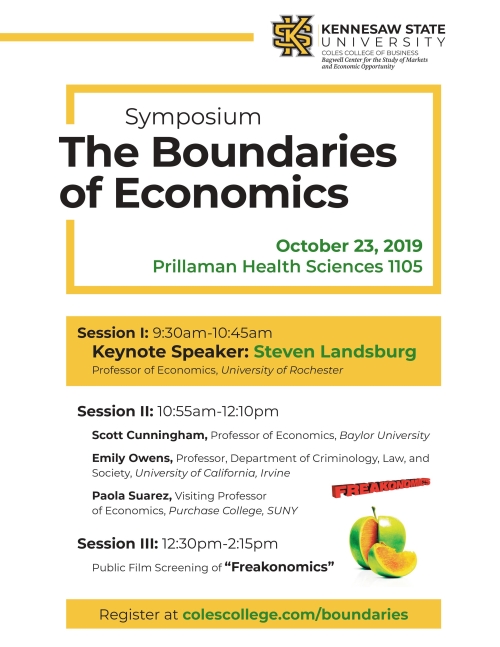Archive for the 'Economics' Category
Here is a headline from this morning’s New York Times:

Over the course of the day, I’ve heard three different radio commenters riffing on this theme, mocking the former president for not realizing that presidents don’t control monetary policy.
The mockers are wrong. They’re even obviously wrong. If interest rates are determined by monetary policy and nothing else, then what determines interest rates in an economy without money, where people still borrow and lend?
Interest rates are largely determined by the difference between prosperity now and expected prosperity in the future. If everyone expects to be a lot richer in ten years, they’ll try to borrow more now and drive interest rates up. If everyone expects to be a lot poorer in ten years, they’ll try to save more now and drive interest rates down. And pretty much everything a president does affects both current and future prosperity, so pretty much everything a president does affects interest rates.
Trump’s promise to bring down interest rates is an implicit promise to adopt policies that either a) make us more prosperous today, but only temporarily and/or b) make us less prosperous in the future. In other words, he’s promising to adopt policies that many of us would describe as short-sighted. The New York Times notwithstanding, he’s perfectly capable of fulfilling that promise. He can, for example, appoint a lot of short-sighted people to influential policy positions.
And we know who some of those people are! The New York Times and the radio commentators completely missed the boat on this one. They thought Trump was promising the impossible, but failed to realize that there’s nothing impossible about filling the Cabinet with childless cat ladies.
My essay on abortion and public policy has appeared in the Summer 2024 issue of the Independent Review, where it will gestate for nine months behind a paywall.
In the meantime, here is a late draft, identical for all practical purposes to the published version. Please note that the Independent Institute (which publishes the Independent Review) holds the copyright, and all requests for reprint rights should go to them, not to me.

I am delighted to announce that the 10th edition of my textbook, Price Theory and Applications, is now available wherever good books are sold. There’s also a free sample chapter.
Here’s what’s special about this edition:
- I started out by rereading large parts of the past several editions, from which I learned that not every change was an improvement. Some things were a lot clearer in edition 7 than in edition 9. (And sometimes vice-versa of course.) I worked hard to make sure that in the tenth edition, every section and subsection would be the best it could be — which sometimes meant resurrecting an old version, or, more often, combining the best of the old and the new.
- In the past, I’ve tried to keep all of the end-of-chapter problem sets to about the same length, which sometimes meant omitting some really great problems. This time, I decided that was stupid. Whenever I had 40 or 50 really good problems, I included them all.
- This edition benefited from the extraordinary talents, wisdom and persistence of the extraordinary Lisa Talpey, who read every draft, called out everything that seemed even slightly unclear, gave me a chance to rewrite, then read it all again, equally carefully, and took me through as many rounds of this as necessary until everything made sense to her. She also caught pretty much all the typos. I am sure that thanks to Lisa, this edition is far friendlier to the reader than any of those that came before.
- For the first time, I designed my own cover! How do you like it?
The publisher’s webpage, and information on ordering for your classes, is here.
I am just back from the G4G conference in Atlanta, where I gave a six-minute talk on how to organize a waiting line. The video of the actual talk will appear on the web eventually, but in the meantime, here is video of my practice run from the night before:
Or, for higher quality video, click here.
 If you’re in the vicinity of the University of Rochester Thursday evening at 5PM (that is, November 9, which is likely to be the date on which you’re reading this), please drop by Meliora 203 for a talk on the recent history of bank failures and financial panics.
If you’re in the vicinity of the University of Rochester Thursday evening at 5PM (that is, November 9, which is likely to be the date on which you’re reading this), please drop by Meliora 203 for a talk on the recent history of bank failures and financial panics.
Our speaker is Professor James Kahn, now of Yeshiva University, late of the New York Federal Reserve bank and the University of Rochester, and one of the people who taught me how to think about economics. The talk will be aimed primarily at undergraduate students, but all are welcome.
Not all podcasts are fun (for either the guests or the viewers) but in my experience all podcasts hosted by Bob Murphy are fun for all involved. You can see the latest here or on YouTube:
Edit: Here is a new and improved version of the post below. I am leaving the original up for historical reasons, but I recommend following the link instead of reading this post.
*****************
Yesterday, I announced on this blog that ChatGPT had failed my economics exam. (All of the questions on this exam are taken from recent final exams in my sophomore-level course at the University of Rochester.) Multiple commenters suggested that perhaps the problem was that I was using an old version of ChatGPT.
I therefore attempted to upgrade to the state-of-the-art GPT-4, but upgrades are temporarily unavailable. Fortunately, our commenter John Faben, who has an existing subscription, offered to submit the exam for me.
The result: Whereas the older ChatGPT scored a flat zero (out of a possible 90), GPT-4 scored four points (out of the same possible 90). [I scored the 9 questions at 10 points each.] I think my students can stop worrying that their hard-won skills and knowledge will be outstripped by an AI program anytime soon.
(One minor note: On the actual exams, I tend to specify demand and supply curves by drawing pictures of them. I wasn’t sure how good the AI would be at reading those pictures, so I translated them into equations for the AI’s benefit. This seems to have had no deleterious effect. The AI had no problem reading the equations; all of its errors are due to fundamental misunderstandings of basic concepts.)
Herewith the exam questions, GPT-4’s answers (in typewriter font) and the scoring (in red):
I am pleased (I think) to announce that I have just submitted to ChatGPT an exam, consisting entirely of questions taken from recent final exams in my sophomore-level intermediate economics class, and it has earned a score of zero. Not only did it earn a score of zero, but several of its answers would have merited negative scores if I were allowed to give them. The answers are in every case egregiously wrong, showing absolutely zero understanding of the basics.
I am frankly a little surprised; I had expected it to get at least a few things right.
Edited to add: If you are looking for the details, look here.

A couple of weeks ago, I was in Las Vegas for the annual meeting of the Association for Private Enterprise Education, where I was honored to give an invited plenary address.
From there, I went directly to Atlanta, where I gave a short talk at the Gathering for Gardner, honoring the legacy of Martin Gardner. There were a lot of other really cool talks too.
I am sorry that the Las Vegas talk was not recorded and that the recording from the Atlanta talk won’t be available for a few months. Therefore I sat down in front of my webcam and repeated both talks, sticking as close to the original words as my memory would allow. Unfortunately there is no way to recreate the audience reaction or the question and answer periods.
Click below to view either or both of those re-creations.

|

|
The second talk is essentially a six-minute excerpt from the first. It surely benefited from the discussions here, here and here, and most especially from the comments of Bennett Haselton.
A few more words about escalators for those who care about this kind of thing:
Continue reading ‘Where I’ve Been’
Economists, like everyone, should admit to their mistakes and correct them. That’s what this post is for.
The argument against taxing capital income runs like this:
1) Current and future consumption should be taxed at the same rate.
2) A tax on capital income is equivalent to a tax on current consumption coupled with a higher tax on future consumption.
Conclusion: Capital income should not be taxed.
I made this argument several years ago in a talk at the Cato Institute. I recently got a complimentary note from someone who had just watched the video of that talk, which caused me to go back and watch a few snippets to remind myself of what I’d done to earn this compliment. And I was mortified to see myself stating not point 1) above, but this far more general point:
1′) All things should be taxed at the same rate.
The status of 1′) is complicated. It is true that in an ideal world, all things including leisure would be taxed at the same rate. But in a world where you can’t tax leisure, the ideal tax system is far more complicated, with the optimal tax on each consumption good varying according to various elasticities and cross-elasticities of demand and supply. So 1′) is true in an ideal world, but surely false in our world, where leisure is very difficult to tax.
Fortunately the full generality of 1′) was not needed for my argument; all I actually used was 1). But in the video, I very clearly stated 1′) as if it were gospel, and even devoted an entire slide to it. This mistake doesn’t overturn the conclusion, but it’s still surely egregious enough that if, say, Paul Krugman had made a mistake like this, I’d have been all over him.
So: Mea culpa.
A subsidiary point: The word “should” in these statements can be interpreted in (at least) two ways — from the point of view of efficiency and from the point of view of fairness. In the few paragraphs above, and in the bulk of my Cato talk, I was using the word “should” in the first sense. But I also tried to address fairness issues in the Cato talk, and from that angle, I’m less sure that 1′) is wrong.
There’s been a lot of chatter lately, in print and on the web, about whether hospitals should refuse to treat unvaccinated Covid patients. Among other things, it’s been pointed out that there are potential logistical nightmares in trying to ascertain whether a patient is vaccinated before treating him, especially in emergency situations.
But it seems to me that the hospitals never were the right institutions to making these decisions in the first place — the insurance companies are. Why haven’t the insurance companies announced that they won’t cover the costs of Covid care unless you’re vaccinated? If you show up at the hospital unvaccinated and accept treatment, you’d be on the hook for the costs — at least up to the point where you’re left bankrupt.
Creating appropriate incentives is, after all, a large part of what we pay our insurance companies to do. Nobody wants to buy insurance from a company that approves every claim (and charges commensurate premiums). When you buy insurance, part of what you’re buying is the company’s promise to exercise due diligence and not fritter away its resources. There’s a pretty good argument that subsidizing people to remain unvaccinated counts as frittering.
It seems to me that “no coverage if you’re unvaccinated” would be both good social policy and clearly a win for the insurance companies themselves (because it’s a win for their customers). So the question is—why isn’t it happening?
And here’s where I hit the limits of my knowledge — is there some law that’s preventing this? Or some regulation? Or is it not happening for some other reason that I haven’t thought of?
Proof-of-work crypto mining generates a lot of externalities. Yesterday’s post was about how not to measure those externalities. Today’s is about how to deal with them.
When miners use vast amounts of power, there are two broad categories of externality to worry about. One is environmental damage associated with power usage. Insofar as that’s a social problem, the way to deal with it is to tax power usage. That is the government’s job.
But the other kind of externality is more interesting from a crypto-design point of view. Miners are engaged in an arms race. Each miner makes the system a little more secure. Each miner earns an expected reward for that contribution. But there’s no reason to think that the miner’s reward is commensurate with the social value of the extra security that miner brings, and in fact there are plenty of reasons — at least plausible and possibly compelling — to believe that miners are over-rewarded. Currently, if you complete a Bitcoin block you earn a block reward of 6.25 bitcoins plus transaction fees that seem to be running somewhere around a tenth of a bitcoin, adding up to something in the vicinity of $300,000. It’s a fair guess that miners earn pretty close to zero economic profit, so their costs should be about $300,000 per block or roughly $45 million per day. Society is certainly getting something of value for that $45 million, but if it only takes, say, half as many miners to provide the same value, then we’re overpaying by $22.5 million every day (that being the value of the essentially wasted energy).
[it’s also entirely possible in principle that there is too little mining, in which case you can interchange all the implicit plus and minus signs in what follows.]
If you subsidize something and you get too much of it, the solution is to lower the subsidy. In this case that means lowering the block reward. If you don’t subsidize something and you get too much of it, the solution is to tax it. In this case that means a negative block reward. I don’t see any reason in principle why you couldn’t have a proof-of-work system with negative block rewards, and I think it’s at least plausible that such a system could be optimal. [The way this would work in practice is that the block reward would be subtracted from the transaction fees and then burned.]
A potentially nice side benefit is that you’d be taxing that environmental damage we talked about at the outset. You might believe as I do that if there’s a case for taxing that damage, it ought to be done by the government, not by the Bitcoiners. But if you believe your elected officials are falling down on the job, and if doing part of their job for them is an automatic side benefit of getting your own house in order, that’s a good thing.
I haven’t thought about any of this quantitatively — meaning that I have nothing to say about estimating the optimal tax rate, but there is, I think, a moral — namely:
It is often said that proof-of-work systems inevitably lead to a lot of social waste. The “inevitable” part can’t be true. It’s easy for the system to levy a tax that brings private rewards in line with social benefits.
Of course one possiblity is that with the optimal tax, transaction fees would not be enough to support the miners, in which case the system would collapse. But with such a small transaction demand, the system should collapse, so that’s not a problem.
I am sure that a lot has been thought, and a lot has been written, about optimal block rewards, and equally sure that I’m unfamiliar with most of it. So maybe a reader or two will contribute to my education here.
I continue to struggle with the question of where cryptocurrency gets its value.
(Note: When I say “value”, I mean private value, as reflected in the price. Social value is a whole separate question, for a separate blogpost.)
To be fair, I also struggle a bit with the question of where gold and dollars get their value. So let’s consider some of the reasons various assets might be valuable, and ask which arguments apply to other assets.
1. Gold is valuable because you can use it to make jewelry and electronics. I have no doubt that this is true (which is not the same thing as saying that this is the only reason gold is valuable.)
2. Dollars are valuable because (at least if you are an American) you can use them to pay your taxes. One hears this all the time, and I plead guilty to parroting it from time to time in the past. But it’s stopped making any sense to me. Here’s why: Taxes are foreseeable. In order to pay my taxes on April 15, I don’t need to hold dollars on April 13, let alone in January, February or March. Instead, I either borrow from a home equity line or sell off some bonds on the morning of April 15, and hold the money until the government cashes my check a week or so later. That’s a pretty small contribution to the annual demand for money.
To put this another way, one billion people paying $100 tax bills does not create a demand for a stock of 100 billion dollars. Instead, it creates a demand for 100 billion dollars for about 2% of the year.
Notice then, that despite the superficial similarity, argument number 1 (for gold) and argument number 2 (for dollars) are crucially different, because in order to have gold jewelry or gold electronics, you’ve got to have gold pretty much permanently employed as jewelry or electronics, whereas in order to pay your taxes with dollars, you can hire your dollars on the spot market and then be rid of them.
3. Dollars are valuable because you can use them to make small unexpected purchases. Yes, this makes sense. I have a $20 bill in my pocket right now precisely in case I want to buy some ice cream on a whim. When I go to a street fair, I carry even more.
4. Dollars are valuable because you can use them to make large, planned, and (if you care about this) anonymous transactions. Presumably this is why a lot of dollars spend a lot of time in suitcases traveling back and forth between the United States and Colombia. I buy this one.
5. Crypto (e.g. Bitcoin) is valuable because you can use them to make large, planned, and (if you care about this) irreversible transactions. I buy this one, but as you’ll see below, I don’t think it can explain a high price for Bitcoins.
Now: How does all of this apply to understanding why people hold dollars, gold and crypto?
1. There is, I think, no good analogue of jewelry/electronics when it comes to Bitcoin (or for that matter when it comes to dollars). That’s one step toward understanding gold and zero steps toward understanding Bitcoin.
2. There is also no good analogue of paying taxes when it comes to Bitcoin. On the other hand, as noted above, I’ve stopped believing this explains much of anything anyway, so I’ll count this as zero steps toward understanding anything.
3. For small unexpected purchases, at least with current technology, dollars seem to clearly dominate Bitcoin, for a variety of reasons including (most crucially) the lack of transaction fees. So I’m going to count this as one step toward understanding dollars and zero steps toward understanding Bitcoin.
4,5. That leaves large, anonymous transactions, and/or transactions that you want to be irreversible. For this, I believe Bitcoins are often far better than dollars. But (you might say paradoxically), this very feature should make Bitcoins less valuable, not moreso. Here’s why: If I want to move a lot of wealth around the world using dollars, I need to hold a lot of dollars for a substantial period of time. If I and my trading partners want our transactions to stay anonymous, we might hold on to those dollars for a much longer time, rather than facing the trouble of re-acquiring them the next time we need them. But if I want to move a lot of wealth around the world using Bitcoin, I can (not with perfect ease, but a lot more easily than with dollars) acquire them moments before I want to transfer them, and be done with them. There’s no reason for me to tie up my wealth in a non-interest bearing asset before it’s absolutely necessary — and with Bitcoin, relative to dollars, it’s not absolutely necessary until quite late in the game.
So — and again, call this a paradox if you want to: The better Bitcoin serves its purposes, the less it should cost (in terms of dollars). If Bitcoin (or some other cryptocurrency) improves to the point where nobody has any reason to hold it for more than a second, its price will be close to zero. One reason dollars are worth as much as they are is that dollars are relatively clumsy, so to use them, you’ve got to hold them a while.
That, then, is one small step for dollars and zero steps for Bitcoin.
I am not saying there’s no reason Bitcoin should be valuable. I’m saying that whatever the reason might be, I don’t get it. And I’m pretty sure that most of the things you hear on this subject are just plain wrong.
There is another reason why Bitcoin is harder to understand than dollars, and that’s this: Dollars have just one price (basically the number of apples or haircuts you have to sell to acquire a dollar). Bitcoins have two prices — the number of dollars you need to buy a Bitcoin and the dollar value of the fees you pay every time you transact. Any argument that starts with “demand is high (or supply is limited) so the price should be high” is instantly suspect until one sorts out which of the two prices is being explained here, and why. But that’s a separate topic, which I already blogged on last week, so I’ll stop here and end with a question:
Can anyone give me a plausible reason (not necessarily a slam-dunk correct reason, just a plausible one) why cryptocurrency should have any value at all, except during the course of a speculative bubble?

Can you spot the flaw in this argument?
1) Over time, Bitcoin will become increasingly important as a global currency.
2) Therefore, over time, the price of Bitcoin must rise.
The first is a statement of (alleged) fact and hence not (in its raw form) susceptible to logical analysis. This is not a post about whether it is true, probable, possible, improbable or false. I’m just going to accept it for the sake of argument.
The problem occurs at the word “Therefore”.
I suppose that what underlies the “therefore” in some people’s minds is some instinct like this: “Prices have to equilibrate supply and demand. With supply fixed and demand growing, the price must rise”.
Here’s exactly where that argument goes wrong: Bitcoin has two relevant prices: The price of the asset itself and the transaction fee you pay every time you use it. If the transaction fee rises to equilibrate the supply and demand for transactions, there’s no obvious reason for the price of the asset to rise.
In other words: Yes, it is true that fixed supply plus rising demand implies a rising price. But when there are two prices, it’s not immediately obvious which one must rise.
I can easily imagine a world like this:
1) The demand for Bitcoin transactions is extremely high.
2) Therefore the transaction fee is extremely high.
3) Therefore people use Bitcoin only for large transactions. Large transactions tend to be foreseeable. (I don’t buy a car without first thinking about it for a while.) Therefore there’s plenty of time to acquire Bitcoin just in time to make my transaction. Otherwise, there’s no reason to hold it. (And plenty of reason not to, just as there’s plenty of reason not to hold any other non-interest-bearing asset. For example, if you’re hedging against inflation, you can buy interest-bearing inflation-indexed bonds.)
4) Therefore, at any given moment, the demand for Bitcoin is quite low, although the demand for transactions is quite high.
It seems to me that much of what I read about the supply and demand for Bitcoin starts from the assumption that we can model the demand for Bitcoin the same way we model the demand for dollars or euros. But neither dollars nor euros have transaction fees, and that seems to me to make a world of difference.
Am I missing something?
I had the honor of giving the commencement address to this year’s graduating economics majors at the University of Rochester, under circumstances that were trying in several ways.
First, I learned at 10:10 PM on Friday that I was giving this talk on Saturday morning. (It’s a long story. All the communication failures leading up to this were entirely my own fault.) I got to bed rather late that night.
Second, it was so ungodly hot that I chose to shed my cap and gown.
Third, there were, I think, only about 80 students present, spread evenly around a 967 seat auditorium (family and other guests were not allowed). Laughter and applause were therefore pretty sparse (though I suppose they might have been sparse for other reasons) and even what little could be heard was mostly not picked up by the microphones.
Other than that, I thought it was a good day. Those who have seen my 2017 commencement talk will recognize roughly the first quarter and the last tenth of this one, which I recycled. The intervening 65% or so is new.
Or click here.
“
It’s always a pleasure to do a Podcast with a host who is thoughtful, understands the issues, and engages in meaningful dialogue instead of just mindlessly plowing through a list of prepared questions. Remarkably many fail to clear that bar. Alex Epstein clears it easily. My interview with him is here.
 Note: This is strictly a post about Bitcoin as a payment system. If you have something to say about Bitcoin as a store of value, a bubble or a long-term investment, you are off topic.
Note: This is strictly a post about Bitcoin as a payment system. If you have something to say about Bitcoin as a store of value, a bubble or a long-term investment, you are off topic.
That said, I want to think about the interaction between transaction fees, seignorage and the number of miners. I’m sure there are people who have thought far harder about this than I have, and I dare to expect that some of those people are reading this. I hope one or more of those people will let me know whether I’m thinking about it correctly.
It seems to me that at least in the short run, the following things are more or less fixed:
a) The cost of mining (call it C)
b) The maximum possible daily transaction volume (call it T)
c) The fee per transaction at which users demand exactly T daily transactions (call it F)
d) The daily seignorage earned by miners (that is the newly minted Bitcoins that a miner receives upon successfully completing a block). (Call it S.)
Now:
1) There is free entry into mining; therefore each miner has to earn C. If there are M miners, then the total revenue earned by miners is CM.
2) That total revenue breaks into two parts: Transaction fees, which total TF per day, and seignorage, which totals S per day.
3) So CM = TF + S, or M = (TF + S)/C , where everything on the right side of that equation is more or less fixed in the short run.
4) If the seignorage were to stop flowing (as it will on some fixed date in the near future), then the equation becomes M=TF/C.
5) Currently, the value of S is about 9 times the value of TF (these are my crude off-the-cuff estimates; see below). Therefore TF/C is about 10% of (TF + S)/C. In other words, when the seignorage disappears, the number of miners should fall to about 10% of the current number.
(Of course many of the things I am treating as more-or-less fixed can change, so this is a ceteris paribus calculation, not a forecast.) My questions (below the fold for those who are reading this on my website):
Marty Makary, Professor of Health Policy at Johns Hopkins, as quoted by Alex Tabarrok:
Ironically, those in the Oxford-AstraZeneca trial who inadvertently received half the initial vaccine dose had lower infection rates
Makary and Tabarrok’s main point (with which I fully agree) is that it’s criminally stupid for the FDA not to approve the A-Z vaccine immediately — and their main argument would stand with or without the observation about infection rates.
But I’m quoting the same observation for an entirely different reason: To point out that sometimes you need economics to explain the medical data.
In particular: Half-dosed subjects will generally have fewer side effects. Subjects with fewer side effects will think it more likely that they’ve gotten the placebo. Subjects who think they’ve gotten the placebo are going to continue taking more precautions with masks, social distancing, etc. Therefore it’s entirely plausible that half-dosed subjects will have lower infection rates.
Thanks to Romans Pancs for pointing me in this direction, and reminding me of the Thanksgiving puzzle that I posted here.
If you’re wealthy enough to be sure you’ll never spend it all, you might be thinking — especially at this time of year — about giving away some of the excess. Unfortunately, that’s impossible.
What you can do is force some people to give to other people, and you might very well want to do that. But as for your own excess wealth, you can’t give it away, because you already have.
There are two ways to explain this. Pretty much everyone agrees that one explanation is much clearer than the other, but it seems like they’re split about evenly as to which is the clearer one. So I’ll offer both and you can take your choice.
I hold this truth to be self-evident: It is downright crazy to try to distribute vaccines without using prices. I said as much last week.
The question then becomes: How should those prices be implemented?
Method I: Distribute vaccine rights randomly and let people trade them. This suffers from the fact that you can’t know how much the vaccine is really worth to the people you’re bargaining with, which is a barrier to efficient bargaining.
My immediate instinct (which I still think is a pretty good one) is (after pre-vaccinating certain key groups like first responders and health care workers) to give everyone a choice: You can have your vaccine now, or you can have a check for (say) $500 and your vaccine in six months. This suffers from the need to get the price right (presumably involving some trial and error) but I stand by it as far far better than the Soviet-style central planning we’re about to actually get.
But now Romans Pancs has done far better than I have, by actually thinking about the details of the optimal auction design and getting them right. His paper is here. (You’ll need to sign up for a free account before downloading.) Anyone who actually cares about getting vaccines distributed efficiently should start by reading this paper.
Here is a scenario not unlike many that could well play out in the near future, courtesy of our friends at the Centers for Disease Control:
- Edna, age 65 and retired, lives alone and likes it. She gets along well with her neighbors but prefers not to socialize much. She’s entirely comfortable with her Kindle, her Netflix, and her Zoom account, which she uses to keep in touch with her family. She does look forward to the day when she can hug them again, but for the time being, she’s wistfully content.
- Irma, age 62 and retired, lives alone but mostly lives to dance. In normal times, she’s out dancing five nights a week, and out with friends most afternoons. Confined to her apartment, she’s feeling near suicidal.
- Tina, age 65 and a corporate CEO, has discovered, somewhat to her surprise, that she can do her job via Zoom as well as she can do it from her office. It took a little getting used to, but with all the time she saves commuting, she’s actually able to work more effectively, and everything’s humming along just as it should.
-
Gina, age 58 and also a corporate CEO, has a very different management style. She’s accustomed to popping into her managers’ offices unannounced at all times of day to keep tabs on what’s going on, and she’s found that this way of working is extremely effective for
her. Since the pandemic started, she’s lost her grip and the corporation is foundering.
Now: A vaccine becomes available. The CDC decides that people over 65 will be near the front of the line to receive it.
Question 1: Should Edna be allowed to sell her place in line to Irma? Should Tina be allowed to sell her place to Gina?
Question 2: Do you think the CDC will allow that?
I am quite sure that the answer to Question 1 is yes, and nearly as sure that the answer to Question 2 is no. Which means something is wrong.
It is tragic that so much of pandemic-management policy has been made in defiance of basic science. It is equally tragic that so much policy is about to be made in defiance of basic economics. Because if there’s one thing that economics teaches us, it’s that you cannot distribute a scarce resource efficiently unless you use the price system. No bureaucrat at the CDC has enough information to distinguish Edna from Irma, or Tina from Gina. Therefore they won’t even try.
Essentially everyone understands that it would be insane to try to distribute food or housing or pretty much anything else without using prices. But when it comes to Covid vaccines, the reasoning seems to be that vaccine distribution is uniquely important, so we should do a uniquely bad job of it. Go figure.
If you think it would be a nightmare for all the Edna/Irma and Tina/Gina pairs to negotiate individual contracts, there’s a simpler way to accomplish the same thing: Let Irma and Gina buy their way to the front of the line, then take all the money you collect and redistribute it to the population as a whole so that Edna and Tina get their shares. In other words, let the price system do its job.
There are (at least) two ways to test the efficacy of a vaccine. The Stupid Way is to administer the vaccine to, say, 30,000 volunteers and then wait to see how many of them get sick. The Smarter Way is to adminster the vaccine to a smaller number of (presumably much better-paid) volunteers, then expose them to the virus and see how many get sick.
A trial implementing the Smart Way is getting underway at Imperial College London. In the United States, we do things the Stupid Way, at least partly because of the unaccountable influence of a tribe of busybodies who, having nothing productive to do, spend their time trying to convince people that thousands of lives are worth less than dozens of lives. Those busybodies generally refer to themselves as Ethicists, but I think it’s always better to call things by informative names, so I will refer to them henceforth as Embodiments of Evil.
Last night, while I was attempting to calculate the amount of damage that these Embodiments of Evil have caused, I was interrupted by a knock on my door. It turned out to be a man from Porlock, who wanted to consult me on some mundane issue. At first I tried to turn him away, explaining that I was in the midst of a difficult calculation and could not be distracted. But my visitor brought me up short by reminding me that the economist’s job is not just to lament bad policies, it’s also to figure out ways to circumvent them. So we put our heads together and this is what we came up with:
First, design a vaccine trial that is, to all appearances, set up the Stupid Way. We vaccinate people, we let them go their own ways, and we track what happens. But we add one twist: Any volunteer who gets sick after being vaccinated receives an enormous payment. Call it something like “Compassionate Compensation”.
Here are the advantages:
Continue reading ‘Vaccine Testing: The Smart and Sneaky Way’
People who have a lot of money very rarely give it away. Some invisible hand prevents them.
| —Iris Murdoch |
| Henry and Cato |

For cost-benefit analysis, the usual ballpark figure for the value of a life is about $10,000,000. But I keep hearing it suggested that when it comes to fighting a disease like Covid-19, which mostly kills the elderly, this value is too high. In other words, an old life is worth less than a young life.
I don’t see it.
People seem to have the intuition that ten years of remaining life are more precious than one year of remaining life. That’s fine, but here’s a counter-intuition: An additional dollar is more precious when you can spend it at the rate of a dime a year for ten years than when you’ve got to spend it all at once — for example, if your time is running out. (This is because of diminishing marginal utility of consumption within any given year). So being old means that both your life and your dollars have become less precious. Because we measure the value of life in terms of dollars, what matters is the ratio between preciousness-of-life and preciousness-of-dollars (or more precisely preciousness-of-dollars at the margin). If getting old means that the numerator and the denominator both shrink, it’s not so clear which way the ratio moves.
Instead of fighting over intuitions, let us calculate:
Suppose you’re a young person with 2 years to live and 2N dollars in the bank, which you plan to consume evenly over your lifetime, that is at the rate of $N per year. I’ll write your utility as
Suppose also that you’re willing to forgo approximately pX dollars to avoid a small probability p of immediate death. Then (by definition!) X is the value of your life. (The reasons why this is the right definition are well known and have been discussed on this blog before. I won’t review them here.) This means that
= U(N,N) – (pX/2)U1(N,N) – (pX/2)U2(N,N)
(where the last equal sign should be read as “approximately equal” and the Ui are partial derivatives).
Because you’ve optimized, U2(N,N) = U1(N,N), so we can write
[I am happy to turn this space over to my former colleague and (I trust) lifelong friend Romans Pancs, who offers what he describes as
a polemical essay. It has no references and no confidence intervals. It has question marks. It makes a narrow point and does not weigh pros and cons. It is an input to a debate, not a divine revelation or a scientific truth.
I might quibble a bit — I’m not sure there’s such a thing as a contribution to a debate that nobody seems to be having. I’d prefer to see this as an invitation to start a thoughtful and reasoned debate that rises above the level of “this policy confers big benefits; therefore there’s no need to reckon with the costs before adopting it”. That invitation is unequivocally welcome. ]
| —SL |
The Main Argument
It is a crime against humanity for governments to stop a capitalist economy. It is a crime against those whom the economic recession will hit the hardest: those employed in the informal sector, those working hourly customer service jobs (e.g., cleaners, hairdressers, masseurs, music teachers, and waiters), the young, the old who may not have the luxury of another year on the planet to sit out this year (and then the subsequent recession) instead of living. It is a crime against those (e.g., teachers and cinema ushers) whose jobs will be replaced by technology a little faster than they had been preparing for. It is a crime against the old in whose name the society that they spent decades building is being dismantled, and in whose name the children and the grandchildren they spent lifetimes nourishing are subjected to discretionary deprivation. Most importantly, it is a crime against the values of Western democracies: commitment to freedoms, which transcend national borders, and commitment to economic prosperity as a solution to the many ills that had been plaguing civilisations for millennia.
Capitalism and democracy are impersonal mechanisms for resolving interpersonal (aka ethical) trade-offs. How these trade-offs are resolved responds to individual tastes, with no single individual acting as a dictator. Governments have neither sufficient information, nor goodwill, nor the requisite commitment power, nor the moral mandate to resolve these tradeoffs unilaterally. Before converting an economy into a planned economy and trying their hand at the game that Soviets had decades to master (and eventually lost) but Western governments have been justly constrained to avoid, Western governments ought to listen to what past market and democratic preferences reveal about what people actually want.
People want quality adjusted life years (QALY). People pay for QALY by purchasing gym subscriptions while smoking and for safety features in their cars while driving recklessly. Governments want sexy headlines and money to buy sexy headlines. Experts want to show off their craft. But people still want QALY, which means kids do not want to spend a year hungry and confined in a stuffy apartment with depressed and underemployed parents; which means the old want to continue socialising with their friends and, through the windows of their living rooms, watch the life continue instead of reliving the WWII; which means the middle-aged are willing to bet on retaining the dignity of keeping their jobs and taking care of their families against the 2% chance of dying from the virus.
Suppose 1% of the US population die from the virus. Suppose the value of life is 10 million USD, which is the number used by the US Department of Transportation. The US population is 330 million. The value of the induced 3.3 million deaths then is 33 trillion USD. With the US yearly GDP at 22 trillion, the value of these deaths is about a year and a half of lost income. Seemingly, the country should be willing to accept a 1.5 year-long shutdown in return for saving 1% of its citizens.
The above argument has three problems that overstate the attraction of the shutdown:
- The argument is based on the implicit and the unrealistic assumption that the economy will reinvent itself in the image of the productive capitalist economy that it was before the complete shutdown, and will do so as soon as the shutdown has been lifted.
- The argument neglects the fact that the virus disproportionately hits the old, who have fewer and less healthy years left to live.
- The argument neglects the fact that shutting down an economy costs lives. The months of the shutdown are lost months of life. Spending a year in a shutdown robs an American of a year out of the 80 years that he can be expected to live. This is a 1/80=%1.25 mortality rate, which the society pays in exchange for averting the 1% mortality rate from coronavirus.
It is hard to believe that individuals would be willing to stop the world and get off in order to avert a 1% death rate. Individuals naturally engage in risky activities such as driving, working (and suffering on-the-job accidents), and, more importantly, breathing. Allegedly, 200,000 Americans die from pollution every year. Halting an economy for a year would save all those people. Stopping the economy for 15 years would be even better, and save all the lives that coronavirus would take. Indeed, stopping the economy is a gift that keeps giving, every year, while coronavirus deaths can be averted only once. Yet, with the exception of some climate change fundamentalists, there were no calls for stopping the economy before the pandemic.
The economy shutdown due to coronavirus seems to be motivated by the same lack of faith in progress and society’s ability to mobilise to find technological solutions (if not for this strain of the virus then for the future ones), and by the Catholic belief in the virtue of self-flagellation of the kind sported by climate-change fundamentalists of Greta’s persuasion. This lack of faith is not wholly the responsibility of governments and is shared by the citizens.
Edited to add: As Salim suggests in comments, the entire problem is that I assumed an implausible value for wealth (which should be interpreted as lifetime consumption). With a more plausible number, everything makes sense. Mea culpa for not realizing this right away. I will leave this post up as a monument to my rashness, but have inserted boldfaced comments in appropriate places to update for my new understanding.
This is bugging me. It’s a perfectly simple exercise in valuing lives for the purposes of cost-benefit analysis. I would not hesitate to assign it to my undergraduates. But it leads me to a very unsettling and unexpected place, and I want to know how to avoid that place.
It’s also a little geeky, so I hope someone geeky will answer — ideally, someone geeky who thinks about this stuff for a living.
Start here: You’re a trapeze artist who currently works without a net. There’s a small probability p that you’ll fall someday, and if you fall you’ll die. You have the opportunity to buy a net that is sure to save you. What are you willing to pay for that net?
Well, let’s take U to be your utility function and W your existing wealth. If you don’t buy the net, your expected utility is
p U(death)+(1-p) U(W)
But we can simplify this by adding a constant to your utility function so that U(death)=0. So if you don’t buy the net, your expected utility is just
(1-p )U(W)
If you do buy a net at price C, then you’re sure to live, with utility
U(W-C) = U(W) – C U′ (W)
where the equal sign means “approximately equal” and the approximation is justified by the assumption that the probability of falling (p) is small, so your willingness to pay (C) is presumably also small.
Equating these two expected utilities gives me C = p U(W)/U′ (W). If we set V = U(W)/U′ (W), then C = pV. That is, you’re willing to pay pV to protect yourself from a p-chance of death. This justifies calling V the “value of your life” and using this value in cost-benefit calculatios regarding public projects that have some small chance of saving your life (guard rails, fire protection, etc.)
So far, so good, I think. But now let’s see what happens when we posit a particular utility function.
I will posit U(W) = log (W), which is a perfectly standard choice for this sort of toy exercise, though actual real-world people are probably a bit more risk-averse than this. Except I can’t just leave it at U(W) = log(W), because my analysis requires me to add some constant T to make the utility of death equal to zero.
So let’s take E to be the income-equivalent of death; that is, living with E dollars is exactly as attractive as not living at all. Then I have to choose T so that log(E) + T = 0. In other words, T = -log(E).
Now I know that, with your current wealth equal to W, the value of your life is U(W)/U'(W) = W log(W/E) .
Now as a youngish but promising trapeze artist, you’ve probably got some modest savings, so lets make your current wealth W=50,000 (with everything measured in dollars). (Edited to add: This was the source of all the difficulty. W represents something like lifetime consumption, so 50,000 is a ridiculously small number. Let’s go with 5 million instead.) Then here is the value of your life, as a function of E, the income-equivalent of death.
If E = .0001 (that is, if dying seems just as attractive to you as living with your wealth equal one-one-hundredth of a penny), then the value of your life is $1 million. (Edited to add: This should actually be E= 4.1 million dollars, which is considerably more than one-one-hundredth of a penny.)
If E = 6.92 x 10-82, then the value of your life is $10 million. (Edited to add: This should be E = $677,000 which might be a plausible figure.)
If E = 1.29 x 10-864, then the value of your life is $100 million. (Edited to add: This should be E equal to about one cent, which is of course implausible, but that’s fine, because a $100 million value of life is also implausible.)
Edited to add: I won’t continue to edit the details in the rest of this post, but I think this is all straightened out now. Thanks to those who chimed in, and sorry to have taken your time on this!
Now I am extremely skeptical that you, I, or anyone else is capable of envisioning the difference between living on 10-82 dollars and living on 10-864 dollars. Yet the decision of whether to value your life at $10 million or at $100 million hinges entirely on which of these seems more to you to be the utility-equivalent of death.
There is some purely theoretical level at which this is no problem. It is possible that you’d rather die than live on 10-864 dollars and would rather live on 10-863 dollars than die. But I am extremely skeptical of any real-world cost-benefit analysis that hinges on this distinction.
(And this is the range in which we have to be worried, since empirical estimates of the value of life tend to come in somewhere around $10 million.)
If I make you less risk-averse — say with a relative risk aversion coefficient of 4 — almost the entire problem disappears. But the tiny part that remains is still plenty disturbing. Then I get:
If E = .007 (that is, about 2/3 of a penny), the value of your life is $1 million.
If E = .003 (about 1/3 of a penny), your life is worth $10 million.
If E = .0015 (a sixth of a penny), your life is worth $100 million.
So we need to tell the folks in accounting to value your life at either $1 million or $100 million, depending on where you draw the suicide line between having two thirds of a penny and having one sixth of a penny.
This is nuts, right? And how squeamish should it make me about the whole value-of-life literature? And what, if anything, am I missing?





